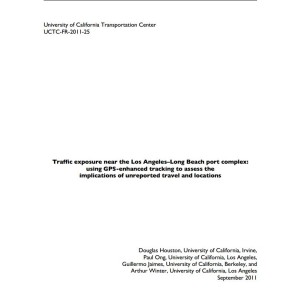
Authors: Douglas Houston, Paul Ong, Guillermo Jaimes, Arthur Winer
Date: September 1, 2011
Traffic exposure assessments could misclassify the extent and locations of exposure if traditional recall surveys and self-reported travel diaries do not record all participant activities. The Harbor Communities Time Location Study (HCTLS) examines the nature, extent and implications of underreported locations/trips in a case study which used portable Global Positioning Systems (GPS) devices to track the diurnal patterns and traffic exposure of 47 residents of communities near the Los Angeles–Long Beach port complex. Participants were similar to adults nationwide in time spent indoors, in-vehicle, and outdoors, but spent more time indoors at home (78% vs. 66%). Overall, participants did not report nearly half (49%) of the locations and trips identified in GPS-enhanced data on their activity diaries, resulting in about 3 h/day in unreported locations and 0.6 h/day in unreported trips. The probability of a location/trip being underreported was systematically correlated with participant and location/trip characteristics. Self-reported data missed about 50 min of heightened air pollution exposures during the 5 h/day on average participants spent in high-traffic areas and about 30 min during the 4 h/day near truck routes. GPS-enhanced methods provide opportunities to more precisely characterize exposure periods and tools to identify facility, roadway, and land use types of the greatest concern for mitigation efforts.
Link to Publication